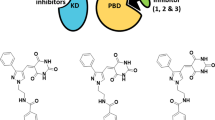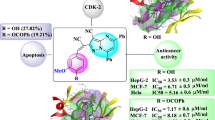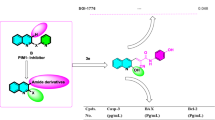Summary
PLK1 has an important role in the regulation of cell cycle and represents an important target for cancer treatment. This enzyme belongs to the Polo-like kinases family, which is characterized by a regulatory domain named Polo-box domain (PBD). Rather than regular kinase inhibitors, this domain provides high selectivity to PLK1. Here, we report on four novel PLK1 PBD inhibitors identified by cytotoxicity screening and fluorescence polarization assay of a chemical library of natural and semisynthetic compounds. These compounds revealed two- to three-fold higher selectivity to the PDB of PLK1 than to those of the related family members, PLK2 and PLK3. These four substances inhibited tumor cell growth of sensitive CCRF-CEM and multidrug-resistant CEM/ADR5000 leukemia cells. The tested compounds increased the apoptotic cell fraction, which indicates apoptosis as a major mechanism of cell death. Cell cycle analysis showed compound (5) arrested the cell cycle of CCRF-CEM cells in the G2/M phase, while the other three molecules ((compound (3), compound (4), and compound (6)) exerted pronounced cytotoxicity with an increase of cells in the sub-G1 population. Molecular docking was performed for the understanding of ligand-protein interaction, the tested candidates showed strong binding affinity to PLK1 PBD. In conclusion, we identified four new chemical scaffolds that may serve as lead compounds for the development of selective PLK1 inhibitors in the future.





Similar content being viewed by others
Abbreviations
- CDK:
-
cyclin-dependent kinase
- IC50 :
-
50% inhibition concentration
- PBD:
-
Polo-box domain
- PC:
-
Polo-box cap
- PLK:
-
Polo-like kinase
- DAPK-2:
-
death-associated kinase 2
References
Van Vugt MATM, Medema RH (2005) Getting in and out of mitosis with polo-like kinase-1. Oncogene 24:2844–2859
Moshe Y, Boulaire J, Pagano M, Hershko A (2004) Role of polo-like kinase in the degradation of early mitotic inhibitor 1, a regulator of the anaphase promoting complex/cyclosome. Proc Natl Acad Sci U S A 101:7937–7942
Lowery DM, Lim D, Yaffe MB (2005) Structure and function of polo-like kinases. Oncogene 24:248–259
Seki A, Coppinger J a, Jang C-Y et al (2008) Bora and the kinase Aurora a cooperatively activate the kinase Plk1 and control mitotic entry. Science 320:1655–1658
Ohkura H, Hagan IM, Glover DM (1995) The conserved Schizosaccharomyces pombe kinase plol , required to form a bipolar. Genes Dev:1059–1073
Lane HA, Nigg EA (1996) Antibody microinjection reveals an essential role for human polo-like kinase 1 (Plk1) in the functional maturation of mitotic centrosomes. J Cell Biol 135:1701–1713
Nigg EA (1998) Polo-like kinases: positive regulators of cell division from start to finish. Curr Opin Cell Biol 10:776–783
Sanhaji M, Ritter A, Belsham HR et al (2014) Polo-like kinase 1 regulates the stability of the mitotic centromere-associated kinesin in mitosis. Oncotarget 5:3130–3144
Weichert W, Ullrich A, Schmidt M et al (2006) Expression patterns of polo-like kinase 1 in human gastric cancer. Cancer Sci 97:271–276
Li H, Wang H, Sun Z et al (2017) The clinical and prognostic value of polo-like kinase 1 in lung squamous cell carcinoma patients: immunohistochemical analysis. Biosci Rep 37:BSR20170852
Schöffski P (2009) Polo-like kinase (PLK) inhibitors in preclinical and early clinical development in oncology. Oncologist 14:559–570
Berg A, Berg T (2016) Inhibitors of the polo-box domain of polo-like kinase 1. Chem Bio Chem 17:650–656
Rudolph D, Steegmaier M, Hoffmann M et al (2009) BI 6727, a polo-like kinase inhibitor with improved pharmacokinetic profile and broad antitumor activity. Clin Cancer Res 15:3094–3102
Raab M, Pachl F, Kramer A et al (2014) Quantitative chemical proteomics reveals a Plk1 inhibitor-compromised cell death pathway in human cells. Cell Res 24:1141–1145
Liu X (2015) Targeting polo-like kinases: a promising therapeutic approach for Cancer treatment. Transl Oncol 8:185–195
García-Alvarez B, de Cárcer G, Ibañez S et al (2007) Molecular and structural basis of polo-like kinase 1 substrate recognition: implications in centrosomal localization. Proc Natl Acad Sci U S A 104:3107–3112
Liu F, Park JE, Qian WJ et al (2012) Identification of high affinity polo-like kinase 1 (Plk1) polo-box domain binding peptides using oxime-based diversification. ACS Chem Biol 7:805–810
Elia AEH, Rellos P, Haire LF et al (2003) The molecular basis for phosphodependent substrate targeting and regulation of Plks by the polo-box domain. Cell 115:83–95
Mann J (2002) Natural products in cancer chemotherapy: past, present and future. Nat Rev Cancer 2:143–148
Johnson IS, Armstrong JG, Gorman M, Burnett JP (1963) The Vinca alkaloids: a new class of oncolytic agents. Cancer Res 23:1390–1427
Demain AL, Vaishnav P (2011) Natural products for cancer chemotherapy. Microb Biotechnol 4:687–699
Yin Z, Song Y, Rehse PH (2013) Thymoquinone blocks pSer/pThr recognition by plk1 polo-box domain as a phosohate mimic. ACS Chem Biol 8:303–308
Zhang G, Zhang Z, Liu Z (2013) Scytonemin inhibits cell proliferation and arrests cell cycle through downregulating Plk1 activity in multiple myeloma cells. Tumor Biol 34:2241–2247
Hamdoun S, Fleischer E, Klinger A, Efferth T (2017) Lawsone derivatives target the Wnt/β-catenin signaling pathway in multidrug-resistant acute lymphoblastic leukemia cells. Biochem Pharmacol 146:63–73
Saeed M, Kuete V, Kadioglu O et al (2014) Cytotoxicity of the bisphenolic honokiol from Magnolia officinalis against multiple drug-resistant tumor cells as determined by pharmacogenomics and molecular docking. Phytomedicine 21:1525–1533
Kuete V, Mbaveng AT, Sandjo LP et al (2017) Cytotoxicity and mode of action of a naturally occurring naphthoquinone, 2-acetyl-7-methoxynaphtho[2,3-b]furan-4,9-quinone towards multi-factorial drug-resistant cancer cells. Phytomedicine 33:62–68
Reindl W, Yuan J, Krämer A et al (2008) Inhibition of polo-like kinase 1 by blocking polo-box domain-dependent protein-protein interactions. Chem Biol 15:459–466
Reindl W, Strebhardt K, Berg T (2008) A high-throughput assay based on fluorescence polarization for inhibitors of the polo-box domain of polo-like kinase 1. Anal Biochem 383:205–209
Reindl W, Gräber M, Strebhardt K, Berg T (2009) Development of high-throughput assays based on fluorescence polarization for inhibitors of the polo-box domains of polo-like kinases 2 and 3. Anal Biochem 395:189–194
Sakkiah S, Senese S, Yang Q et al (2014) Dynamic and multi-pharmacophore modeling for designing polo-box domain inhibitors. PLoS One 9:1–9
Scharow A, Raab M, Saxena K et al (2015) Optimized Plk1 PBD inhibitors based on Poloxin induce mitotic arrest and apoptosis in tumor cells. ACS Chem Biol 10:2570–2579
Lapenna S, Giordano A (2009) Cell cycle kinases as therapeutic targets for cancer. Nat Rev Drug Discov 8:547–566
Strebhardt K (2010) Multifaceted polo-like kinases: drug targets and antitargets for cancer therapy. Nat Rev Drug Discov 9:643–660
Strebhardt K, Ullrich A (2006) Targeting polo-like kinase 1 for cancer therapy. Nat Rev Cancer 6:321–330
Liu X, Lei M, Erikson RL (2006) Normal cells , but not Cancer cells , survive severe Plk1 depletion. Mol Cell Biol 26:2093–2108
Lei M, Erikson RL (2008) Plk1 depletion in nontransformed diploid cells activates the DNA-damage checkpoint. Oncogene 27:3935–3943
Yuan J, Sanhaji M, Krmer A et al (2011) Polo-box domain inhibitor poloxin activates the spindle assembly checkpoint and inhibits tumor growth in vivo. Am J Pathol 179:2091–2099
Qin T, Chen F, Zhuo X et al (2016) Discovery of novel polo-like kinase 1 polo-box domain inhibitors to induce mitotic arrest in tumor cells. J Med Chem 59:7089–7096
Shan HM, Shi Y, Quan J (2015) Identification of green tea Catechins as potent inhibitors of the polo-box domain of polo-like kinase 1. ChemMedChem 10:158–163
Chen Y, Zhang J, Li D et al (2016) Identification of a novel polo-like kinase 1 inhibitor that specifically blocks the functions of polo-box domain. Oncotarget 8:1234–1246
Syed N, Smith P, Sullivan A et al (2006) Transcriptional silencing of polo-like kinase 2 ( SNK / PLK2 ) is a frequent event in B-cell malignancies. Blood 107:250–256
Yang Y, Bai J, Shen R et al (2008) Polo-like kinase 3 functions as a tumor suppressor and is a negative regulator of hypoxia-inducible factor-1?? Under hypoxic conditions. Cancer Res 68:4077–4085
Brożek J, Bryl E, Płoszyńska A et al (2009) P-glycoprotein activity predicts outcome in childhood acute lymphoblastic leukemia. J Pediatr Hematol Oncol 31:493–499
Dhooge C, De Moerloose B, Laureys G et al (1999) P-glycoprotein is an independent prognostic factor predicting relapse in childhood acute lymphoblastic leukaemia: results of a 6-year prospective study. Br J Haematol 105:676–683
Wu CP, Hsieh CH, Hsiao SH et al (2015) Human ATP-binding cassette transporter ABCB1 confers resistance to Volasertib (BI 6727), a selective inhibitor of polo-like kinase 1. Mol Pharm 12:3885–3895
Ferrarotto R, Goonatilake R, Young Yoo S et al (2016) Epithelial-mesenchymal transition predicts polo-like kinase 1 inhibitor-mediated apoptosis in non-small cell lung Cancer. Clin Cancer Res 22:1674–1686
Mailand N, Bekker-Jensen S, Bartek J, Lukas J (2006) Destruction of Claspin by SCFbTrCP restrains Chk1 activation and facilitates recovery from genotoxic stress. Mol Cell 23:307–318
Elowe S, Hümmer S, Uldschmid A et al (2007) On BubR1 regulates the stability of kinetochore – microtubule interactions. Genes Dev 21:2205–2219
Peters U, Cherian J, Kim JH et al (2006) Probing cell-division phenotype space and polo-like kinase function using small molecules. Nat Chem Biol 2:618–626
Elia AEH (2003) Proteomic screen finds pSer/pThr-binding domain localizing Plk1 to mitotic substrates. Science 299(80):1228–1231
Acknowledgements
We extend our thanks to Angela Berg (Leipzig University) for analysing compound activities in fluorescence polarization assays.
Funding
Fluorescence polarization assays work was supported by the Deutsche Forschungsgemeinschaft (INST 268/281–1 FUGG). S.A. is grateful to the German Academic Exchange Service (DAAD) for a PhD stipend.
Author information
Authors and Affiliations
Corresponding author
Ethics declarations
Conflict of interest
Sara Abdelfatah declares that she has no conflict of interest. Edmond Fleisher declares that he has no conflict of interest. Annette Klinger declares that she has no conflict of interest. Vincent K. W. Wong declares that he has no conflict of interest. Thomas Efferth declares that he has no conflict of interest.
Ethical approval
This article does not contain any studies with human participants or animals performed by any of the authors.
Informed consent
For this type of study, formal consent is not required.
Additional information
Publisher’s note
Springer Nature remains neutral with regard to jurisdictional claims in published maps and institutional affiliations.
Rights and permissions
About this article
Cite this article
Abdelfatah, S., Fleischer, E., Klinger, A. et al. Identification of inhibitors of the polo-box domain of polo-like kinase 1 from natural and semisynthetic compounds. Invest New Drugs 38, 1–9 (2020). https://doi.org/10.1007/s10637-019-00752-0
Received:
Accepted:
Published:
Issue Date:
DOI: https://doi.org/10.1007/s10637-019-00752-0




